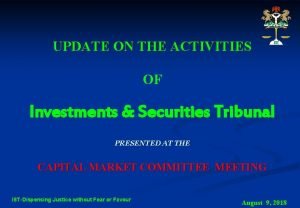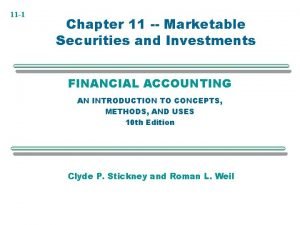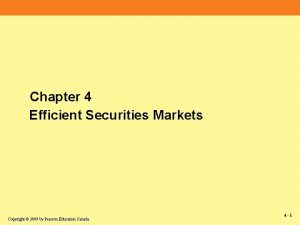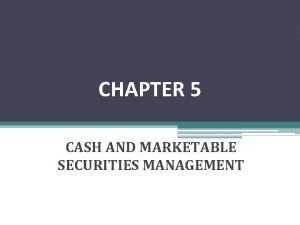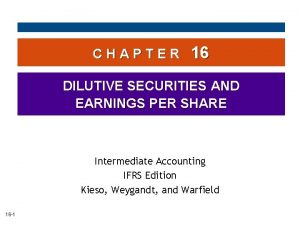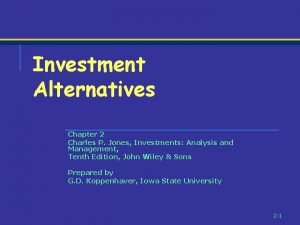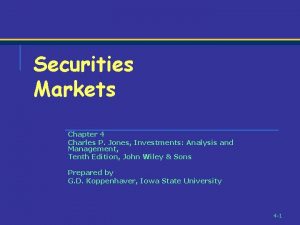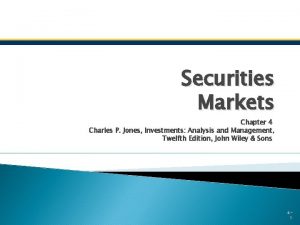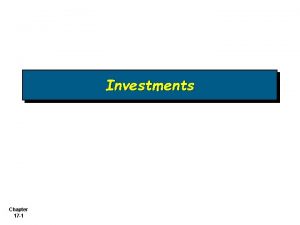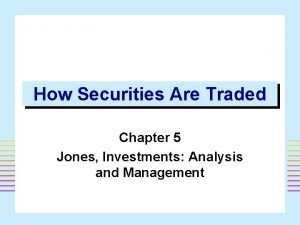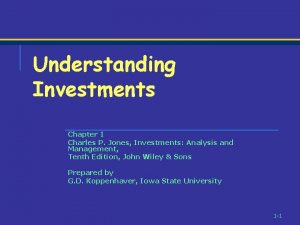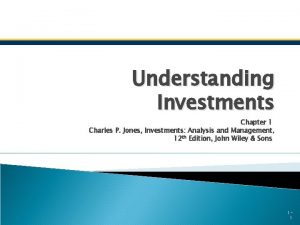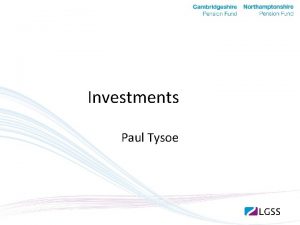Securities Markets Chapter 4 Jones Investments Analysis and















- Slides: 15

Securities Markets Chapter 4 Jones, Investments: Analysis and Management 1

The Role of Financial Markets Help firms and governments raise cash by selling claims against themselves n Provide a place where investors can act on their beliefs n Help allocate cash to where it is most productive 2 n Help lower the cost of exchange n

Markets in New Securities n New securities are issued in a primary market – n Initial public offerings versus seasoned new issues Issue facilitated by investment banker – – Specialists in advice, design, and sales Intermediaries between issuer and 3 investor

Investment Banking Client advice includes type and features of security, offer price, and timing of sale n Underwriting services: Risk of selling to investors assumed from issuer n Coordinates marketing by helping issuer register securities, issue 4 prospectus, and sell securities n

Investment Banking n Rule 415 (shelf rule) allows certain issuers to sell new securities over time after filing a single registration – n Reduces issuance cost A private placement means new securities are sold to a small group of institutional investors – Registration not required 5

Secondary Markets where investors trade previously issued securities n Auction markets involve bidding in a specific physical location n – – n Brokers represent investors for a fee Others trade for their own account Negotiated markets consist of decentralized dealer network 6

Stock Exchanges n NYSE is a secondary auction market for equity securities – – – n A member-owned organization Listing requirements for traded firms “Specialists” assigned to each traded equity to make a market in that stock AMEX and regional exchanges list smaller firms, have less volume than 7 NYSE

Over-the-counter Markets n Network of dealers standing ready to either buy or sell securities at specified prices – – n Dealers profit from spread between buy and sell prices Handle unlisted securities NASDAQ: Competing dealers make markets in OTC stocks 8

Third and Fourth Markets Third Market: Over-the-counter transactions in securities listed on organized exchanges n Fourth market: Trading network among investors interested in buying and selling large blocks of stock n – – Brokers, dealers bypassed so costs low Electronic or telephone network 9

Foreign Markets n US equity markets account for a third of world’s stock market capitalization – n Many different equity markets exist Emerging markets – Generally less regulation and standardization of trading activity – Risks: Illiquidity, lack of information, political uncertainty 10

Equity Market Indicators Provide a composite report of market behavior on a given day n Dow Jones Industrial Average n – – Composed of 30 “blue-chip” stocks Price-weighted index: Essentially adds the prices of 30 stocks, divides by 30 » – Adjusted for stock splits, stock dividends Oldest, most well-known measure 11

Equity Market Indicators n Standard & Poor’s Composite Index – – – Composed of 500 “large” firm stocks Expressed as index number relative to a base index value of 10 (1941 -43) Value-weighted index: Prices and shares outstanding considered » Indicates how much the average equity value of the 500 firms in the index has increased relative to the base period 12

Equity Market Indicators n NYSE and NASDAQ Composite Indices – n Value-weighted indices of broad markets Nikkei 225 Average – Price-weighted index of 225 activelytraded stocks on the Tokyo Stock Exchange 13

Bond Markets n Secondary bond market is primarily an over-the-counter network of dealers – Treasury and agency bonds actively trade in dealer markets » n Municipal bonds less actively traded NYSE is the largest centralized bond market of any exchange 14 – Mostly corporate bonds, thinly traded

Market Developments n Growth of institutional trading associated with: – Block trading of stocks (transactions of at least 10, 000 shares) » – n Affects market structure and operation Negotiated, not fixed, commissions Evolution of National Market System – Centralized system for price and activity 15 reporting, order routing and sequencing
 Capital markets tribunal
Capital markets tribunal Investments in marketable securities
Investments in marketable securities How would you define efficient security markets
How would you define efficient security markets Chapter 11 real estate and other investments
Chapter 11 real estate and other investments Marketable securities management
Marketable securities management Basic earnings per share
Basic earnings per share Kieso chapter 17
Kieso chapter 17 Intermediate accounting chapter 17 investments test bank
Intermediate accounting chapter 17 investments test bank Chapter 2 investments
Chapter 2 investments Why study financial markets and institutions chapter 1
Why study financial markets and institutions chapter 1 Characteristics of consumer behavior
Characteristics of consumer behavior Chapter 9 expanding markets and moving west
Chapter 9 expanding markets and moving west Business markets and business buyer behavior chapter 6
Business markets and business buyer behavior chapter 6 Changes in an individual's behavior arising from experience
Changes in an individual's behavior arising from experience Chapter 5 consumer markets and buyer behavior
Chapter 5 consumer markets and buyer behavior Chapter 9 expanding markets and moving west
Chapter 9 expanding markets and moving west
